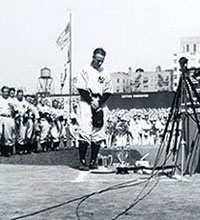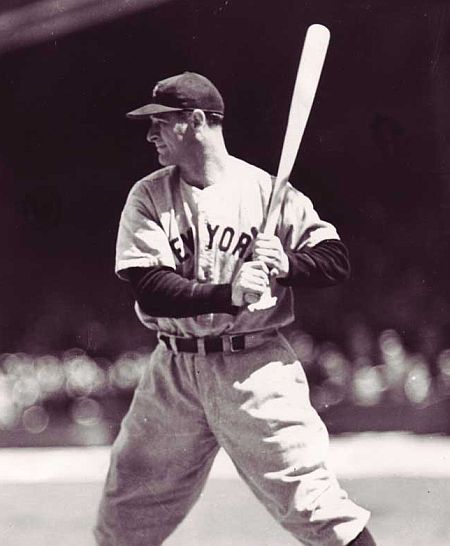“…I consider myself the luckiest man on the face of the earth.” – Lou Gehrig, July 4, 1939
 For over 56 years he owned the record for most consecutive games played–2,130– by a Major League Baseball (MLB) player. Since his retirement over 71 years ago, he has remained MLB’s career leader in grand slams, with 23. Along with these historic achievements on the baseball diamond, the “Iron Horse” Lou Gehrig, who was born 107 years ago today, will forever be linked with a quote from his famous speech, delivered in front of over 60,000 fans between games of a doubleheader at Yankee Stadium on July 4, 1939.
For over 56 years he owned the record for most consecutive games played–2,130– by a Major League Baseball (MLB) player. Since his retirement over 71 years ago, he has remained MLB’s career leader in grand slams, with 23. Along with these historic achievements on the baseball diamond, the “Iron Horse” Lou Gehrig, who was born 107 years ago today, will forever be linked with a quote from his famous speech, delivered in front of over 60,000 fans between games of a doubleheader at Yankee Stadium on July 4, 1939.
Henry Louis Gehrig was born on June 19, 1893 at his parents’ home at 1994 Second Avenue in Yorkville, a lower-middle class section of Manhattan. His father, Heinrich, and mother, Christina, were German immigrants who had four children, though only Lou survived infancy. Heinrich was a metalworker who suffered from occasional bouts of unemployment and poor health and Christina was often relied upon to support the family by working as a maid and a baker.
Gehrig spent the early part of his boyhood in Yorkville before his family moved to the Washington Heights section of Manhattan. Weighing nearly fourteen pounds at birth, Gehrig was a large and sturdily built youth who was a solid but unspectacular student. He endured some taunting about his heritage during the anti-German sentiment common among Americans during the U.S. involvement in World War I, but Gehrig enjoyed many friendly relationships with a diverse group of classmates at the all-boys Commerce High School. Mainly because of his mother’s demands that he get a good education and not become what she called “a bummer” and with the aid of a Columbia University athletic department official who knew her, Gehrig matriculated at Columbia and played football and baseball for the school beginning in 1922.
Despite his mother’s desire that her only child remain at the prestigious Columbia, Gehrig stayed there for only one year. His success on the baseball field led the New York Yankees to offer him a bonus and salary totaling $3,500 for the 1923 season. Gehrig struggled with the decision, but with both his parents suffering from various physical ailments, he signed the deal on April 30. Less than two months later, Gehrig made his debut. He spent most of 1923 and 1924 in the minor leagues, but in the 23 games he did play, he batted nearly .500 and knocked in 14 runs in just 36 at bats.
It was clear to Yankees coaches that Gehrig was capable of being a key player as the 1925 season began. The problem was finding a place for him to play. Gehrig was a first baseman, but his path to that position was blocked by a hitter and sterling fielder named Wally Pipp. Few other spots were open on the Yankees, who had two American League pennants and one World Series championship over the past four seasons. But the 1925 Yankees were struggling. Missing their injured superstar Babe Ruth and already thirteen-and-a-half games out of first place on June 3, manager Miller Huggins decided to shakeup the batting lineup (the popular story that Pipp asked to sit because of a headache is inaccurate, though he did suffer a serious head injury weeks later after getting beaned during batting practice). Included in that shakeup was the insertion of Lou Gehrig as the first baseman. Gehrig, who played the day before and connected for a pinch-hit single, would play in every Yankees game for almost 14 years.
 During this streak of 2,130 consecutive games played, Gehrig amassed some of the most impressive statistics in the history of baseball, while forging his reputation as one the game’s greatest clutch hitters, leaders, and winners. The steady, left-handed, number four of the Yankees would finish his career with a .340 batting average and he ranks among the top five all-time in runs batted in (1995), slugging percentage (.632), and on-base percentage (.447). He won the AL triple crown in 1934 by leading the league in batting average, home runs, and runs batted in and he finished among the top ten in AL Most Valuable Player voting eight times, winning the award in 1927 and 1936. With Gehrig as a linchpin of their lineup, the Yankees won the World Series seven times (counting his abbreviated 1939 season), including in 1927, which is still considered by many baseball experts as the greatest baseball team ever assembled.
During this streak of 2,130 consecutive games played, Gehrig amassed some of the most impressive statistics in the history of baseball, while forging his reputation as one the game’s greatest clutch hitters, leaders, and winners. The steady, left-handed, number four of the Yankees would finish his career with a .340 batting average and he ranks among the top five all-time in runs batted in (1995), slugging percentage (.632), and on-base percentage (.447). He won the AL triple crown in 1934 by leading the league in batting average, home runs, and runs batted in and he finished among the top ten in AL Most Valuable Player voting eight times, winning the award in 1927 and 1936. With Gehrig as a linchpin of their lineup, the Yankees won the World Series seven times (counting his abbreviated 1939 season), including in 1927, which is still considered by many baseball experts as the greatest baseball team ever assembled.
Gehrig’s production fell off in 1938, though by most players’ standards, he still had a successful year. Following that season, Gehrig experienced increasingly serious and difficult physical problems, particularly with his strength, balance, and coordination. After beginning the 1939 season with only four singles in his first eight games, Gehrig approached his manager Joe McCarthy while the Yankees prepared to take on the Detroit Tigers and asked to be left out of the lineup. After an extensive series of tests at the Mayo Clinic, which concluded that he was suffering from amyotrophic lateral sclerosis, ALS. Now commonly referred to as Lou Gehrig’s Disease, ALS is a progressive, incurable, and terminal disease of the central nervous system. His playing career was undoubtedly over. The devastating diagnosis would bring continued deterioration, paralysis and ultimately death.
Still stunned by the news of Gehrig’s condition, the Yankees organized a Lou Gehrig Day at Yankee Stadium on July 4, 1939. In between games of a doubleheader versus the Washington Senators, Gehrig was praised in speeches and showered with various gifts. But the moment most indelibly etched in the memories of baseball fans was Gehrig’s address to the crowd, which was later dramatized in the popular 1942 film, “Pride of the Yankees.” Gehrig prepared his words beforehand, but when he stepped to the microphone he spoke from memory:
Fans, for the past two weeks you have been reading about the bad break I got. Yet today I consider myself the luckiest man on the face of the earth. I have been in ballparks for seventeen years and have never received anything but kindness and encouragement from you fans…
When the New York Giants, a team you would give your right arm to beat, and vice versa, sends you a gift — that’s something. When everybody down to the groundskeepers and those boys in white coats remember you with trophies — that’s something. When you have a wonderful mother-in-law who takes sides with you in squabbles with her own daughter — that’s something. When you have a father and a mother who work all their lives so that you can have an education and build your body — it’s a blessing. When you have a wife who has been a tower of strength and shown more courage than you dreamed existed — that’s the finest I know.
So I close in saying that I might have been given a bad break, but I’ve got an awful lot to live for. Thank you.
 Gehrig lived less than two years after this memorable Independence Day speech at Yankee Stadium. Because of his terminal prognosis, the Baseball Hall of Fame took the rare step of waiving the five-year post-retirement waiting period and voted and inducted Gehrig into their elite membership. He was named by Mayor Fiorello LaGuardia to an official post with the New York City Parole Board before his ALS prevented him from working anymore. Lou Gehrig, who sportswriter Jim Murray would later describe as, “a symbol of indestructability–a Gibraltar in cleats”–died at his home in Riverdale, the Bronx section of New York City not too far from Yankee Stadium, on June 2, 1941, exactly 16 years after he began his consecutive games played streak. He was survived by his wife, Eleanor, who never remarried and died in 1984. The couple had no children.
Gehrig lived less than two years after this memorable Independence Day speech at Yankee Stadium. Because of his terminal prognosis, the Baseball Hall of Fame took the rare step of waiving the five-year post-retirement waiting period and voted and inducted Gehrig into their elite membership. He was named by Mayor Fiorello LaGuardia to an official post with the New York City Parole Board before his ALS prevented him from working anymore. Lou Gehrig, who sportswriter Jim Murray would later describe as, “a symbol of indestructability–a Gibraltar in cleats”–died at his home in Riverdale, the Bronx section of New York City not too far from Yankee Stadium, on June 2, 1941, exactly 16 years after he began his consecutive games played streak. He was survived by his wife, Eleanor, who never remarried and died in 1984. The couple had no children.




